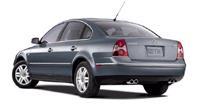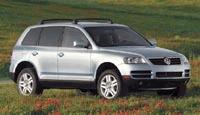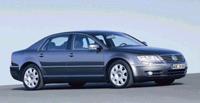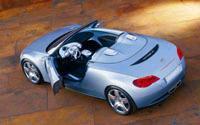Forbes Looks at New Models for Rich Folks
 VW Passat W-8 |
 VW Toureg |
 VW Phaeton |
 VW Concept R |
Volkswagen: Moving Up By Jerry Flint
NEW YORK September 30, 2003; Forbes.com published this special feature.
Most people think of Volkswagen as a German company that makes low-priced cars. That's not exactly wrong, but it's changing.
VW's Concept R two-seat roadster.
In the U.S., VW sells the New Beetle, which runs from less than $20,000, to the mid-twenties for the convertible and hot turbo versions. Golf hatchbacks are in the same price range, while Volkswagen's best sellers here, the Jetta sedan and wagon, are priced a bit higher. VW's biggest passenger cars, the Passat sedan and wagon, start in the mid-twenties.
But look at what's new and coming:
• Last year VW brought out an eight-cylinder version of its Passat, the W-8, which stickers for about $40,000.
• The Touareg sports utility vehicle was introduced a few months ago. The other day I saw one (a V-8) with a $49,000 sticker, but $40,000 is a good price for a well-equipped six-cylinder model.
• The Phaeton, a big sedan, that's already on the market in Europe, is coming here at the end of this year, with either an eight-cylinder (335 horsepower) or 12-cylinder engine (420 horsepower), with prices probably running between $60,000 and $85,000. This car is to complete with the large BMWs, Mercedes, Ford Motor's Jaguar, and Toyota's Lexus sedans. As we say in New York, Volkswagen is moving up to the East Side.
• The Microbus, a retro design of the VW van of the 1960s, is expected in the fall of 2006 as a 2007 model. My guess is that it will have a base price of $35,000. Also likely to arrive at about the same time: the Concept R two-seat roadster, which should start at $35,000.
• Another model is in the works--something between the Passat and the Phaeton--to compete with DaimlerChrysler's Mercedes-Benz E Class and the BMW 5 Series. "It will not be a traditional sedan, not a coupe, not even a four-door coupe," says Bernd Pischetsrieder, the VW chief, as quoted in AutoWeek. My guess is a very sporty four-door, priced around $55,000.
That's just the Volkswagen brand.
VW's Phaeton will be in the U.S. at the end of the year.
The company also bought Lamborghini and Bentley, and is expanding both lineups. Bugatti, now in the VW stable, has a $1 million supercar in development. And, of course, there is Audi which is VW's successful upscale division.
The pursuit of the luxury market was the dream of the now-retired VW chief, Ferdinand Piech. He is part of the Porsche family, which might explain his love for higher-priced cars.
What's the early word on VW's foray into this new territory? In the U.S. it moved just 1,200 Passat W-8s. Very slow. The new Touareg SUV sold 2,225 last month and fewer than 4,000 this year to date. That's fine so far, but it's too early to tell.
The Phaeton is off to a slow start in Europe, where VW moved fewer than 3,000 in the first year. The long-term goal is for annual worldwide sales of 15,000 to 20,000 cars, including 4,000 to 5,000 in the U.S.
The Touareg SUV.
VW's greatest problem is to get new and richer customers to buy a vehicle with a VW emblem on the nose instead of one that reads Mercedes, BMW or Lexus--or even Audi.
Then there is the quality issue: the New Beetle, for example, has been plagued with problems. I personally know one woman who sold her New Beetle after less than one year because she could not stand the defects. And I know another who would have sold hers, but it was a gift from her children. In both cases, they loved the car but were fed up with the glitches.
Another hurdle: the Volkswagen dealer body isn't a luxury car group. Many dealers are dueled with another nameplate. In fact, only a third of VW's dealers are to get the Phaeton, at least at first. As a rule, people who buy $70,000 cars don't want to rub shoulders with someone who bought one for $18,000. Wealthy customers want to be pampered, and that is a big challenge for the VW organization.
On the plus side, VW does build cars that look good inside and out, and that are known for their exceptionally fine handling.
The Passat W-8.
And VW isn't under the usual pressure to push up profits or its stock price. Its largest stockholder is the German State of Lower Saxony, which is interested in keeping workers on the job and has no interest in telling other German parts suppliers to fire their workers and move the jobs to low-wage countries.
And while it is easy to criticize VW's move upscale, going downscale isn't easy, either. Mercedes ran up huge losses with its two low-priced cars. An early model of its A Class rolled over when a journalist in Europe put in through the "moose test," of making sharp swerves, as if evading a moose. So Daimler added a stability control system, at no charge. It was the right thing to do, as it solved the problem and saved Mercedes' reputation. But it eliminated any chance of profits until the model is redone.
The sales potential for the other small car, the Smart, a cute, but slow, two-seater, was overestimated. An assembly plant and supplier campus was built with the capacity for over 200,000 cars a year, but actual volume has been half that. I estimate that Daimler has lost several billion dollars on this venture.
In short, if Mercedes and BMW are going to build small cars, as they are, then Volkswagen might be smart--and eventually successful--in carrying the battle to their turf.


